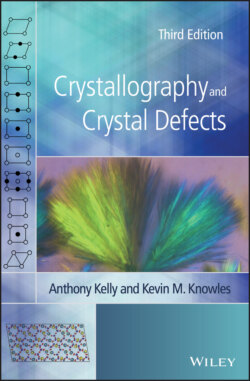Читать книгу Crystallography and Crystal Defects - Anthony Kelly - Страница 41
2.12 Space Groups
ОглавлениеWe showed in Section 1.4 that repetition of an object (e.g. an atom or group of atoms) in a crystal is carried out by operations of rotation, reflection (or inversion) and translation. We have also described in this chapter the consistent combinations of rotations and inversions that can occur in crystals, and in Section 1.8 we described the possible translations that can occur in crystals to produce the 14 Bravais lattices, or space lattices.
However, we have so far not made any attempt to combine the operations of rotation (and inversion) with translation, except briefly in Section 1.5, where it was shown that only one‐, two‐, three‐, four‐, and sixfold rotation axes are compatible with translational symmetry. A full description of the symmetry of a crystal involves a description of the way in which all of the symmetry elements are distributed in space. This is called the space group. There are 230 different crystallographic space groups8; each one gives the fullest description of the symmetry elements present in a crystal possessing that group.
The rotation axes and rotoinversion axes possible in crystals were discussed in Section 2.1 and the possible translations in Section 1.8. An enumeration of the way these axes can be consistently combined with the translation is therefore an enumeration of the possible space groups. Space groups are most important in the solution of crystal structures. They are also very useful when establishing symmetry hierarchies in phase transitions in materials such as perovskites [10–12].
When an attempt is made to combine the operations of rotation and translation, the possibility arises naturally of what is called a screw axis. This involves repetition by rotation about an axis, together with translation parallel to that axis. Similarly, a repetition by reflection in a mirror plane may be combined with a translational component parallel to that plane to produce a glide plane. These will now each be considered in more detail.
